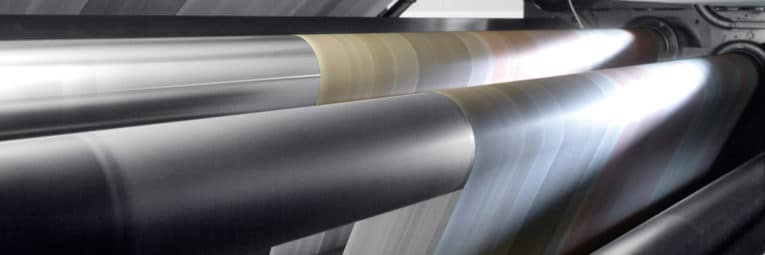
- Home
- All Posts
- Control System
- Web Tension in Slitting and Winding Process
Blog

Web Tension in Slitting and Winding Process
Web tension is the force applied to a continuous web of material in slitting and winding process. Driven rollers can give operator some control over the tension, and undriven rollers can also change the tension because of effects including the drag of bearings and resistance to speed changes. Proper tension is required to reduce waste and downtime, and it’s critical to produce high quality materials including paper, film, foil, rubber, plastic, linoleum, etc.
Importance of web tension
At both rewind and unwind stations, proper tension is necessary to a web so it can be handled through the machine and processes without overstretching. On the other hand, different tension level is required in each individual area, you need to isolate and manage it. Improper tension can cause many material faults such as telescoping rolls, roll blocking, crushed cores, material wrinkles, web stretching, etc.
When tension is too high, web materials may bend, break or neck. Materials will stretch in the machine direction and compress in the cross machine direction. This narrowing of the web width can cause wrinkles to occur. Even worse, high tension breaks will cause the machine to be shut down, rethreaded, restarted and equilibrium be re-established.
When tension is too low, web materials can wrinkle in nips, wrap rollers or cause many other types of troubles. Materials will shrink in the machine direction and web width will widen in the cross machine direction. This widening of the web width can cause wrinkles to occur.
Tension zones: unwind, slitting draw, rewind
Tension zones are commonly categorized as unwind, slitting draw, and rewind. Most slitting and winding applications include these three types of zones. Each zone is unique and should be controlled independently, that means each zone may have its own tension level.
1) In unwind zone, an unwinding roll generally is controlled by brake or motor attached to the shaft or core chuck. The torque applied at the core is transmitted through the radial layers of roll, and futher to produce tension at outside of the roll.
Constant tension is important for unwind porcess, a constant shaft torque will create an increasing tension as the roll diameter decreases, so the torque needs to be varied proportional based on the variation of roll diameter. Besides, roll inertial torque is another factor, diameter is needed to calculate inertial torque during acceleration and deceleration. For example, if the brake or motor is undersized, the roll inertia can drive the web materials into slackness at deceleration.
2) In slitting draw zone, the tension will follow the unwind tension. After the unwind zone, most slitter and rewinders have two or more driven rollers leading up to and through the slitting knives. These rollers are commonly driven by a motor through a chain or belt drive, the relative speeds of driven rollers can be controlled. However the tension is dependent on the unwind tension entering the first driven roller.
Therefore, if you need a constant tension at slitting, constant tension at unwinding should be necessary. Constant tension control is important to keep a constant tension in the slitting area, especially for some stretchy and thin materials. In relative terms, thicker or stiffer materials should be less sensitive to tension variations. Besides, the web material which is not well-tensioned, will degrade quality of slit edge, and slitting tension variation will also change the untensioned slitting width.
3) After the slitting draw zone section, the slitting strands are tensioned by the torque of the winding shafts. The torque applied to the shaft is shared among the rolls winding on that shaft. If the winding rolls have variations on diameter or length, some rolls may tighter than others. The torque applied to a shaft must be proportional to the sum of widths.
The differential winding shafts commonly apply a pneumatic load to the side or inside radius of the core. Torque caused by loaded friction mechanism is proportional to the pneumatic pressure, and the web tension from the torque will decrease inversely with roll radius. On the other hand, for some rolls with large diameter, the weight of roll is another factor which can affect the differential winding tension, the additional frictional torque caused by roll’s weight can increase with the square of the radius.
Roll diameters in unwind and rewind zones is dynamic, so torque and speed should be adjusted constantly for proper tension. In slitting draw zone, tension and speed are more stable because the roll diameters will not change in this zone. Besides, the desired tension levels may be affected by many other factors including web defects, machine defects, splices, ect. The experienced designers from Leap can help you to determine required tension levels for each zone. Sometimes, for some unique slitting and winding machines, the optimal tension levels can be determined only after actually running the web through the slitter and rewinder.
About Lvjie
Serch
Recent Posts
-
Overview of UHMWPE Separato... September 20, 2024
-
Overview of PVC Slitter Rew... July 2, 2024
-
Overview of Pre-coated Film... April 25, 2024
-
Overview of stretch film sl... March 11, 2024
-
Application of BOPP Tape Sl... November 29, 2023
Categories
- All Posts (28)
- Others (1)
- Unwinding Technology (3)
- Rewinding Technology (7)
- Slitting System (18)
- Control System (4)
Contact Info

Xiongzhou Street, Liuhe District, Nanjing City, 211511, China
Phone: 86 025 86555699Email: info@film-slitter.com
Recent Posts
-
Overview of UHMWPE Separato... September 20, 2024
-
Overview of PVC Slitter Rew... July 2, 2024
-
Overview of Pre-coated Film... April 25, 2024
-
Overview of stretch film sl... March 11, 2024
-
Application of BOPP Tape Sl... November 29, 2023
